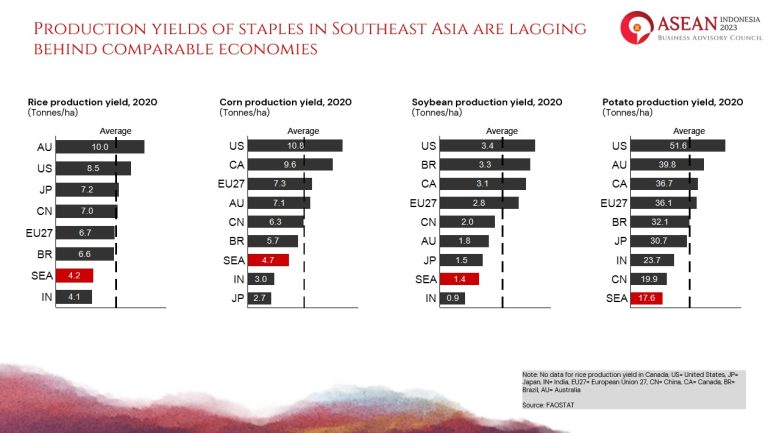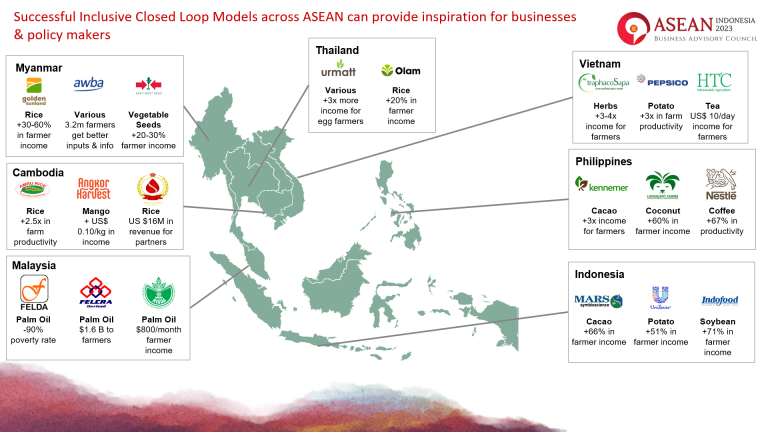Knowledge Base
July 11, 2023 2023-08-08 14:39Knowledge Base
ASEAN BAC Food Security Working Group / Knowledge Base
Knowledge Base
Why is food security a key issue in ASEAN?
Food security is an important issue globally, as well as for ASEAN. While ASEAN has significantly improved its food security and has attracted significant amounts of investments ($48 billion into agriculture as of 2021), there is still room to improve. Approximately 20% of the Southeast Asian population still live at risk of moderate/severe food insecurity.
Productivity of staple foods production like rice, corn and soybean are lagging comparable economies. In addition, costs to maintain a healthy diet in ASEAN are higher than many other regions, including the USA and Europe.
Mengapa Ketahanan Pangan merupakan permasalahan penting di ASEAN ?
Meskipun ASEAN telah meningkatkan ketahanan pangan dan investasi secara signifikan, terdapat beberapa hal yang dapat dioptimalkan. Sekitar 20% populasi Asia Tenggara masih hidup dengan risiko rawan pangan tingkat sedang/berat.
Produktivitas makanan pokok seperti beras, jagung, dan kedelai masih tertinggal dari negara lain. Selain itu, biaya untuk pola makan sehat di ASEAN lebih tinggi dibandingkan dengan banyak wilayah lain, termasuk Amerika Serikat dan Eropa .



Food Security Inclusive Closed Loop Partners
Our inclusive closed loop partners have been included under the Partnership Program segment in Wiki Entrepreneur. They comprise of private companies, institutions or organization who have been developing or participating in inclusive closed loop programs to support MSMEs to scale up, especially for MSMEs in Indonesia.
Click the following button to explore more about these partners and their programs.
Mitra Ketahanan Pangan Inclusive Cloosed Loop
Para Mitra model Inclusive Closed Loop kami terdiri dari perusahaan swasta, institusi atau lembaga yang telah mengembangkan atau berpartisipasi dalam program closed loop untuk mendukung UMKM Indonesia mengembangkan kegiatan bisnis masing-masing.
Klik tombol di bawah untuk mempelajari lebih lanjut tentang para mitra dan programnya.
Key challenges of Food Security in ASEAN
There are four main challenges to achieving food security in Southeast Asia:
Tantangan utama Ketahanan Pangan di ASEAN
Ada empat tantangan utama untuk mencapai ketahanan pangan di Asia Tenggara:
What is the Inclusive Closed Loop?
The Inclusive Closed Loop is a key legacy project that can help address ASEAN’s food security needs. This legacy project is an effective public private partnership initiative that places the farmer at the center of an ecosystem that provides them the necessary support to increase farmer productivity and incomes.
The Inclusive Closed Loop empowers farmers by providing access to finance, knowledge, technology, and offtake markets by engaging government, financial institutions, and various private sector players (e.g., input companies, technology providers, off-takers). Our Food Security Wiki’s “Case studies” section covers a few examples of how this model has been implemented successfully throughout Southeast Asia.
Apa itu Inclusive Closed Loop Model?
Inclusive Closed Loop Model adalah legacy project yang dapat membantu memenuhi kebutuhan ketahanan pangan ASEAN. Legacy Project ini merupakan inisiatif kemitraan antara pihak swasta dan publik yang menempatkan petani di pusat ekosistem yang memberi mereka dukungan yang diperlukan untuk meningkatkan produktivitas dan pendapatan para petani .
Inclusive Closed Loop Model memberdayakan petani dengan cara menyediakan akses ke pembiayaan, pengetahuan, teknologi, dan pasar offtake. Model ini melibatkan pemerintah, lembaga keuangan dan berbagai pihak swasta (contohnya perusahaan input, penyedia teknologi, para off-taker). Bagian “Studi Kasus”: dalam Wiki Wirausaha kami mencakup beberapa contoh bagaimana model ini telah berhasil diterapkan di Asia Tenggara .




